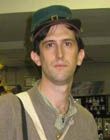|
|
This topic comprises 4 pages: 1 2 3 4
|
|
Author
|
Topic: quick guide to 35mm optical (mono vs. Dolby stereo) & Dolby Analog NR formats by year
|
Brian Dooda
Film Handler
Posts: 16
From: Brooklyn, New York / USA
Registered: Aug 2006
|
 posted 09-19-2006 01:25 PM
posted 09-19-2006 01:25 PM




Guide to Optical Sound Formats (Mono vs. Dolby Stereo)
pre 1927 – Probably Silent, very few exceptions
1927-1975 - Mono**
1975-1985 – probably Mono, few Stereo
1985-1987 – 50/50 Mono or Stereo
post 1987 – probably Stereo
* A Stereo or Mono print will both suffer some quality if played
through the wrong format, but if you are uncertain of a
print, it is best to play back in Mono.
** Although not Dolby Stereo, other "stereo" formats did exist on
some major Hollywood films during these years, the most
popular being Perspecta Sound (1954-1957) and Magnetic
stereo (peaking between 1955-1965).
Guide to Dolby Analog NR Formats (A-type vs. SR-type)
1975-1987 – A-type noise reduction
1987-1995 – probably A-type, few SR-type
1995-1997 – 50/50 A-type or SR-type
post 1997 – probably SR-type
* All prints with a Dolby Digital track (introduced in 1992)
use a SR-type optical sound track
* After 1987 a stereo print could be A-type or SR-type.
There is no way to tell just by looking at the track.
It must be labelled. If you are not certain a stereo
print is A or SR, it is best to play it with A-type
noise reduction.
The years and probabilities of formats are based on figures reported to me by the Dolby librarian of types of sound formats produced each year worldwide. I compared that with figures of films produced annually from film almanacs and focused the years around domestic releases.
[ 09-25-2006, 12:48 PM: Message edited by: Brian Dooda ]
| IP: Logged
|
|
Charles Greenlee
Jedi Master Film Handler

Posts: 801
From: Savannah, Ga, U.S.
Registered: Jun 2006
|
 posted 09-20-2006 12:34 AM
posted 09-20-2006 12:34 AM





On a side note, though this is a valuable, and potentially instructional thread, I'd like to add another entry.
1940 - Fantasound (RCA and Disney). Features 3 descreet channels and a control channel on a dedicated film. The control channel allowed the 3 sound channels to be panned between 2 speakers each, emulating 6 channels. The original surround system.
I add this for factual note, not that anyone will use a Fantasound system, or run into a print. BTW, if you do run into a vintage 1940 print of Fantasia, it will have a mono backup on the print. Doubt you'll ever find the soundtrack film for it though.
| IP: Logged
|
|
|
|
|
|
|
|
|
|
|
|
|
|
|
|
|
|
|
|
|
|
|
|
|
|
|
|
|
|
All times are Central (GMT -6:00)
|
This topic comprises 4 pages: 1 2 3 4
|
Powered by Infopop Corporation
UBB.classicTM
6.3.1.2
The Film-Tech Forums are designed for various members related to the cinema industry to express their opinions, viewpoints and testimonials on various products, services and events based upon speculation, personal knowledge and factual information through use, therefore all views represented here allow no liability upon the publishers of this web site and the owners of said views assume no liability for any ill will resulting from these postings. The posts made here are for educational as well as entertainment purposes and as such anyone viewing this portion of the website must accept these views as statements of the author of that opinion
and agrees to release the authors from any and all liability.
|

 Home
Home
 Products
Products
 Store
Store
 Forum
Forum
 Warehouse
Warehouse
 Contact Us
Contact Us




 Printer-friendly view of this topic
Printer-friendly view of this topic










![[Big Grin]](biggrin.gif) Though I don't remember the date one that one.
Though I don't remember the date one that one.





